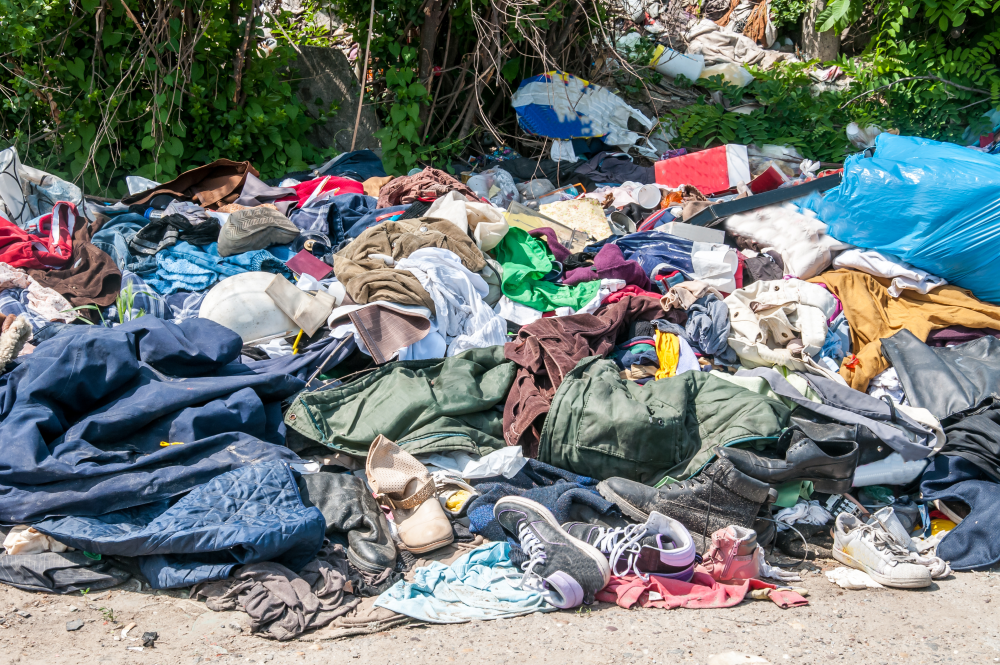Textile Production and Waste, and Its Effects on the Environment

The surge in fast fashion, characterised by inexpensive, trend-driven clothing, is putting a strain on landfill waste due to an overabundance of garments discarded without a second thought. Unsurprisingly, this has significant impacts on the environment, contributing to pollution and greenhouse gas emissions.
Fast Fashion Origins
Fast fashion is the expression coined to describe the rapid design, production and distribution of clothes to keep up with the latest trends, often with a quick turnaround time. Emerging in the 1990s, retailers began quickly reproducing high-end fashion trends for the everyday shopper, giving them ready access to the latest shapes, styles and colours.
Unfortunately, this has led to mass production of garments that are worn a handful of times, before being discarded and often ending their lifecycle in landfill, only a few months or years after production. This has caused garment waste to increase astronomically, with over 92 million tonnes of textile waste produced annually, including 300,000 tonnes in the UK.1
Reasons for Textile Waste
Although many people believe that discarding or donating clothes makes them magically disappear, 85% of all textiles produced go to landfill each year.
But why do so many garments and textiles go to landfill?
Lower wages, due to recessions and a decline in the economy, have resulted in consumers having less disposable income and thus opting for cheaper, less durable clothes and home textiles such as bedding and towels. These lower-quality items have shorter lifespans, which along with being trend-led, result in them being discarded more quickly. Additionally, the lucky few with more disposable income can afford to purchase more for their money, due to the low prices seen in high street and online stores, resulting in them filling wardrobes with clothes only worn for one season.
The rise in trends depicted in the media paired with increasing pressure from social media, especially for younger audiences, to own the latest clothes and home furnishings, has resulted in the rapid pace of consumption leading to frequent purchases and individuals owning more material goods. Amplified by a growing global population, this results in an overall increase in the number of goods being bought and subsequently discarded.
Environmental Impacts
Greenhouse Gas Emissions
Greenhouse gas emissions arise from various stages of the textile production process, from sourcing raw materials to manufacturing items and transporting them.
Although cotton is considered a more environmentally friendly material compared to its synthetic counterparts, cotton fabric requires substantial water and energy resources to be produced, both of which contribute to emissions. On the other hand, synthetic materials, such as polyester, are derived from fossil fuels, with the production process releasing additional greenhouse gases.
Lastly, the transportation of garments to retailers, distribution centres and homes, adds to greenhouse gas emissions. Often, low-quality garments are manufactured in less developed countries due to lower costs, however, this then requires the goods to be transported hundreds of miles across oceans to reach their destination, emitting dangerous gases into the atmosphere.
Landfill Waste
A large portion of textile waste ends up in landfills, decomposing slowly and releasing harmful greenhouse gases into the atmosphere. As waste decomposes in landfills, it releases both methane gas, which is harmful to the environment, and a toxic liquid called leachate, which leaks into the soil and can contaminate water supplies. Additionally, synthetic clothes take on average 200 years to decompose.
Water Usage
Water is required to produce textiles, with over 2,500 litres of water needed to produce just one cotton t-shirt.2 What’s more, dyeing garments contributes to water pollution. This waste water is often dumped into rivers, contaminating water that may otherwise be used for drinking and agriculture. This has a knock-on effect for ecosystems and habitats, causing long-lasting damage to animal populations.
Microplastics
Cleaning and upkeep of low-quality synthetic clothes, such as polyester and nylon, releases microplastics into the environment, with a single load of clothes potentially releasing 700,000 microfibres. The shedding material ends up in oceans, posing threats to habitats and marine ecosystems. Not only does this harm animals and organisms, but the plastic makes its way up the food chain and reaches humans—posing a risk to human health.
Tackling Textile Waste
Focus on Sustainable Design
Designing goods for durability, recyclability, and ease of repair can promote a circular economy, eliminating waste and pollution. This in turn reduces the need for new raw materials, helping to conserve resources.
Encourage Responsible Consumption
One of the main reasons for a rise in textile waste is excess consumption. To tackle this, consumers should be encouraged to make more informed choices on what they purchase, opting for hard-wearing and long-lasting materials and purchasing from trustworthy suppliers that focus on sustainable processes and production. This will help to reduce demand for fast fashion, resulting in less garments being produced and discarded into landfill.
Government Impact
The Government has more responsibility than it accepts and needs to be held accountable for implementing better regulations to promote sustainable production. Better schemes to help the garment industry and individual manufacturers to make sustainable production changes could help decrease the impact on the environment of garment production.
Additionally, increased effort needs to be put into waste management education, by informing consumers on how to make better buying decisions, what they can and can’t recycle and where best to do so, to reduce waste going to landfills.
Outlook
Whilst we can’t solve the issue of current garments in landfill, which will take hundreds of years to decompose, we can implement changes to reduce landfill contributions in the future.
2 Europarl


